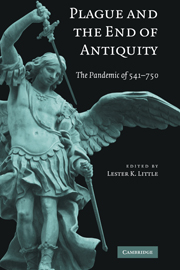6 - Bubonic Plague in Byzantium
The Evidence of Non-Literary Sources
Published online by Cambridge University Press: 05 June 2012
Summary
In the year 540, or shortly thereafter, as part of an on-going campaign to eradicate from the Byzantine Empire the final remnants of classical paganism, the Emperor Justinian ordered that the temple to Isis, at Philae in southern Egypt, be destroyed. According to Plutarch, among the many civilizing skills that mankind had been taught by Isis was that of how to cure disease. That the following year Egypt should have fallen victim to an outbreak of bubonic plague may have struck many adherents of the old gods as a sure sign of the folly of imperial policy. According to the contemporary historian Procopius, the plague first manifested itself at the entrepôt of Pelusium, before spreading to Alexandria, the rest of Egypt, and to Palestine. A harrowing account of the ravages of the plague within Egypt is preserved for us in the writings of John of Ephesus, who witnessed the effects of the disease while traveling to Constantinople via Palestine and Syria in the early 540s. John reports that “it was told about one city on the Egyptian border [that] it perished totally and completely with [only] seven men and one little boy ten years old remaining in it.” By the spring of 542, the disease had reached the imperial capital of Constantinople, where it was believed to have laid low the emperor himself. That same year the plague reached Antioch, Illyricum, Africa, and Spain.
- Type
- Chapter
- Information
- Plague and the End of AntiquityThe Pandemic of 541–750, pp. 119 - 132Publisher: Cambridge University PressPrint publication year: 2006
- 5
- Cited by

